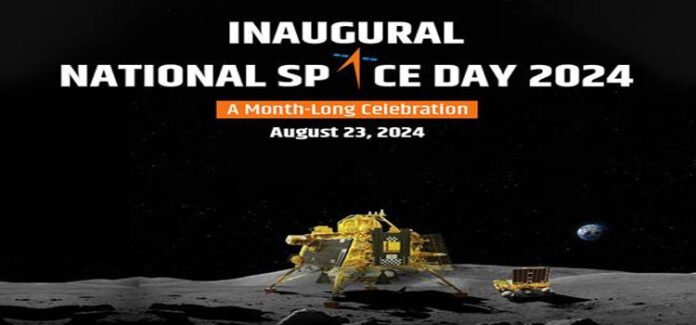India will celebrate the National Space Day on August 23, 2024 for the first time, to mark India’s historic feat of soft landing the Vikram Lander and deploying the Pragyaan rover on the lunar surface at the South Pole of the moon, a year earlier. It made India the fourth country to land on the moon and the first one to get to the south pole of the moon. This achievement placed India in a league of nations running their own space programmes.
Theme of the space day is “Touching Lives while Touching the Moon: India’s Space Saga”. Correspondingly, to describe India’s Space journey, the title “India’s Space Saga” has been given to the celebrations. It is a day to honour the eventful growth and some unsuccessful attempts of the India Space Research Organisation (ISRO) in space exploration and to acknowledge its contribution to the world space community.
Another goal is to attract the young people to this domain besides highlighting the importance of space research and its outcome on almost every part of our life.
National Space Day is thus aimed at celebrating major milestones in space flight and space-based discovery and innovation. It is celebrated with the purpose of firing the interest of the young minds in Astronomy and Space Science and Technology.
Additionally, National Space Day helps increase the nation’s focus on space research, its significance, and contribution to the development of the national pride and unity. It is one of the powerful indications or assertions of how space exploration has changed our lives and the necessity of further supporting and developing this important branch.
National Space Day is thus aimed at celebrating major milestones in space flight and space-based discovery and innovation. It is celebrated with the purpose of firing the interest of the young minds in Astronomy and Space Science and Technology
The National Space Day will thus present India’s incredible feats in space exploration, the social impact of the same, and how citizens of all ages and from all backgrounds can GET excited about the Indian space programme. Several programmes will be held throughout the day including exposition on Indian space missions, fostering a culture of science and technology and particularly an acceleration for the space industry. On the National Space Day other related parties also will stage nationwide events to engage and entertain the people.
India Celebrates
ISRO is the premier agency and champion institution of the Indian Space Programme. Hence, showing many rich space achievements of India, ISRO along with other space agencies will organise events, which would include a grand celebration of National Space Day at Bharat Mandapam with several high-profile sessions, interactive and knowledgeable deliberations, announcements, and a spectacular cultural programme. The celebration consists of various events, such as an exhibition, a seminar and other outreach programs to involve every citizen to celebrate India’s space program.
ISRO along with other space agencies will organise events, which would include a grand celebration of National Space Day at Bharat Mandapam with several high-profile sessions, interactive and knowledgeable deliberations, announcements, and a spectacular cultural programme
The Space Day-2024 events include the scientific community highlighting the space orbiting technique, demonstrations, products, and technology showcases from various ministries, industries, startups, academics, and Department of Science (DoS). These include a National Space Day video, a brief presentation from the Secretary of DoS/Chairman of ISRO, and the Hon’ble Minister of State (Space). The Minister will also declare the results of the ISRO Robotics Challenge and Hackathon and distribute prizes.
Second part of the event includes the special address by the Chairman, ISRO and the Chairman of IN-SPACe, a presentation on socio-economic implications of Indian space program and a keynote address.
The Space Day-2024 events include the scientific community highlighting the space orbiting technique, demonstrations, products, and technology showcases from various ministries, industries, startups, academics, and Department of Science
Panel Discussions will be focused on the subjects such as Space as Governance Solutions, Space Programmes and Roadmaps, Public-Private Partnership, Space Ventures, and Academic Institutions.
Private companies will present their accomplishments in the Space world; company exhibits will be open to the public; film on Chandrayaan-3 and a cultural show will also be presented to mark the occasion. In relation to entertainment, there will also be a series of educational outreach programmes. The major programs are:
A mobile outreach project in the form of mobile exhibition buses to be taken around various universities and colleges on the National Space Day. ISRO has signed an MoU with a well-known science organisation Vijnana Bharati (VIBHA), which works on the propagation of scientific literacy on January 24, 2023, for the execution of a special venture named “Space on Wheels.”
The objective of this programme is to spread awareness of ISRO and India’s space missions among school students at the state level across various Indian states. This venture can be seen as the cooperation between VIBHA and ISRO with the goal of promoting the knowledge in the field of space science and, thus, triggering an increased interest in space research amongst the students.
Showcasing ISRO’s Achievements: The event would showcase ISRO’s competencies in launching rockets, satellites, and their usage, asserting India’s scientific advancements. It was launched on November 8, 2023, with the objective to provide a standardised programme for investigation and advancement of space robotics.
Featuring the tagline “Let’s Build a Space Robot,” this challenge makes students aware of space robotics. Various teams will build robots for an ‘out of this world’ environment, solving real-life issues in space robotics.
The objective of the mobile programme is to spread awareness of ISRO and India’s space missions among school students at the state level across various Indian states
Why are Vikram and Pragyaan Important for India?
Accomplishment of the Vikram Lander and Pragyaan rover mission highlighted various significant technological achievements that India’s space program has accomplished, including the following:
Communication: The Rover being able to get back to the command centre with the minimum of delay, is evidence of India’s advancement in the field of communication technology.
Navigation: India’s capability of precise navigation and topography is seen by the Rovers’ successful navigation around two moon craters.
Temperature Measurement: The sensor that was mounted on the Vikram lander measured vibrations and with that, surface temperature just above and below the moon’s surface was obtained. This goes to show that India has come of age in terms of technological achievement in temperature measurement. The movements of the Pragyaan Rover, commanded from the earth centre, proved India’s robotics control and distances operating expertise.
Technological competency in the context of Lunar Landers, The Indian space shuttle, the Vikram lander for Moon exploration successfully provided a soft landing on the lunar region near the South Pole. This was an historic achievement which showed, how far India has come in developing a lunar lander.
Chandrayaan-3 was another successful mission of India wherein the Propulsion Module (PM) achieved a major transition from Lunar orbit to Earth orbit. This feat established India’s competence in propulsion and orbital operations systems.
Successful Business Transactions
The Indian space initiatives have the potential to bring about commercial advantages, too in a variety of directions, including the following:
Beginning from the 90s up to the present, ISRO has launched 424 foreign satellites earning about $174 million in the process. In the same respect, ISRO has garnered £256 million through satellite launching for different European nations.
Space services: New Space India Limited (NSIL) is the commercial arm of the ISRO. NSIL plays a crucial role in the growth of the Indian space industry. It assists companies in commercialising their space technology and platforms. NSIL makes manufacturing, leasing, purchasing, and trading space components, technology, and other assets for global markets easier. NSIL also facilitates the provision of space services by ISRO and commercial enterprises to international and global organisations, thereby contributing significantly to the global and the Indian space economy.
Start-Ups: The Indian start-up firms in the space industry are flourishing. While there was only one space start-up firm in 2012, the number has increased tremendously, to reach a total of 189 by 2023. Collectively these new businesses recorded a total of $124.6 million. This fast-paced growth clearly indicates the potential of the industry and its prospects are surely very bright.
Regarding the new space economy, in 2021, the Indian Space Sector exhibited a 2% share of the global space economy. The nation has to increase its share to 8 percent by 2030 and to 15 percent by 2047. Research done by World Economic Forum and McKinsey reveal that space industry is likely to be worth $630 billion by 2023. It thus forecasted it to grow by 9% annually and to reach $1.8 trillion by 2035.
The Indian start-up firms in the space industry are flourishing. While there was only one space start-up firm in 2012, the number has increased tremendously, to reach a total of 189 by 2023
Conclusion
To pay homage to some of the major achievements of India and to inspire the next generation to embrace space science as a career option are the two objectives of National Space Day 2024 campaign. This campaign, which is people’s celebration of India’s achievements in the outer space, is a clear indication that the country is set for a quantum leap in the space domain.
Using ISRO, NSIL and IN-SPACe, India has the potential to emerge as one of the dominant players of the global space economy and discover most impactful use for its people and everyone else on the planet. India is a country more than ready to meet the challenge of reaching the final frontier.
—-
The writer is a senior fellow at the Centre for Air Power Studies. Prior to this he was Group Captain in the IAF. He served the IAF for more than three decades in various capacities. He was Director Air Staff Inspections and retired as Director, Joint Control and Analysis Centre. The views expressed are personal and do not necessarily reflect the views of Raksha Anirveda






